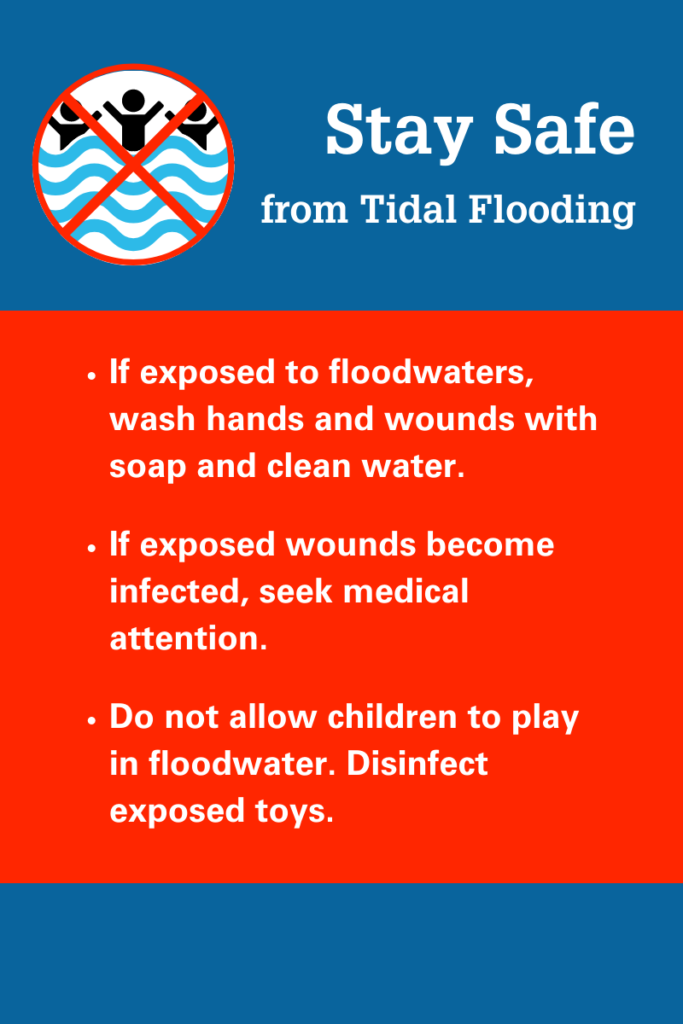Exercise Caution: Tidal Floods May Contain Pollutants
Coastal communities in North Carolina and other states are increasingly dealing with tidal floods. “Tidal floods” refers to the overflowing of saltwater from the ocean and other marine water bodies (sounds, estuaries) onto land.

During these events, tidal floodwaters can become contaminated with various biological and chemical substances. For these reasons, it is recommended to minimize or avoid contact with floodwater to protect our health and the health of our communities.
A multidisciplinary team is trying to better understand the water quality of tidal floodwaters, and ways in which we can protect our health. While the research is ongoing, this fact sheet may be helpful for government officials, researchers, advisory boards, local extension agents, and community outreach teams to better understand the potential health impacts of tidal floodwaters on coastal communities. Specific topics covered in this fact sheet include:
- What is tidal flooding?
- What do we know about the water quality of tidal floods?
- What should I do if I encounter tidal floodwaters?
- Can we predict when tidal flooding may occur?
- How can I learn more about tidal flooding?
What is tidal flooding?
Tidal flooding refers to the temporary overflowing of saltwater onto normally dry land (NOAA 2023; see cover image). Tidal floods occur during high tide events or “king tides,” which are the highest tides of the year. During these periods, tides can rise above and surpass the tops of shorelines, bulkheads, and seawalls, leading to flooding in low-lying areas such as streets.
Tides can also move up through stormwater pipes and out onto roadways. Because these floods occur without rain or storms, they are sometimes referred to as “sunny day” or “blue sky” floods. Rain and storms, however, can worsen the severity of a tidal flood. In some cases, rain, strong wind, and/or large waves can combine with a normal tide and produce flooding. Waterfront properties and low-lying roadways are most likely to be affected by tidal floods.
What do we know about the water quality of tidal floods?
Currently, we know very little about the water quality of tidal floods. Water quality refers to a range of chemical, physical, and biological characteristics of water (USGS 2019). Floodwaters may have poor water quality, as various biological and chemical contaminants may be introduced into the floodwaters from different sources, including yards, urban areas, or wastewater systems (e.g., sewage or septic). Biological contaminants can include bacterial, viral, or protozoan pathogens (e.g., E. coli, Vibrio), and chemical contaminants may include heavy metals (e.g., lead, mercury), pesticides, and industrial chemicals.
While there have been very few published studies that have measured the water quality of tidal floods, it is important to consider the potential impact of water quality on public health in flooded areas. This is because people may walk or bicycle through tidal floodwaters and therefore come into contact with the floodwaters. If the water has poor quality, it may pose a health risk. Even after tidal floodwaters recede, contaminants can remain in the soil of yards, green areas (e.g., playgrounds), or in surrounding wetlands for months (CDC 2021a). More research is needed to better understand the water quality and public health impacts of tidal floods.
What should I do if I encounter tidal floodwaters?
Because any type of floodwater – whether associated with a tidal flood or a storm flood – may contain various biological and chemical contaminants (see above), the U.S. Centers for Disease Control and Prevention (CDC) suggests the following guidance to protect yourself and your family (CDC 2021a, CDC 2022):
- If you have an open wound, avoid exposure to floodwater.
- If you have an open wound and have already been exposed to floodwater, wash it well with soap and clean water and cover it to reduce the chance of infection. If the open wound develops redness, is painful, or appears to be swelling or oozing, seek immediate medical attention.
- If you have been in contact with floodwater, wash your hands with soap and water as soon as possible. Also be sure to wash children’s hands, particularly before consuming food (CDC 2023).
- Do not allow children to play in floodwater. Similarly, do not allow children to play with toys that have been exposed to contaminated floodwaters, but have not been disinfected (CDC 2021b).
- Consider replacing soil, mulch, sand in sandboxes, and wood chips around outdoor playground equipment if they have been exposed to floodwater.
For additional guidance, refer to the following CDC webpages:
- Floodwater After a Disaster or Emergency
- Personal Hygiene During an Emergency
- Cleaning and Sanitizing with Bleach after an Emergency
- Reopening Outdoor Spaces After Flooding
Can we predict when tidal flooding will occur?
The resources below can help you anticipate when tidal floods may occur, or what the current status of tidal flooding is, in your community. In addition, local public officials may issue alerts and guidance related to tidal flooding that may be helpful for communities, and those may be shared on the community’s website as well as on social media or the local news.
National Resources
- For monthly and seasonal predictions of tidal flooding at locations near tide gauges, refer to the National Oceanic and Atmospheric Administration (NOAA) Monthly High Tide Flooding Outlook tool: noaa.gov/high-tide-flooding/monthly-outlook.html
- For real-time advisories on tidal flooding, refer to the National Weather Service Coastal Flood Threat tool: weather.gov/erh/coastalflood
North Carolina Resources
- For an annual calendar of predicted king tide events in North Carolina, refer to the North Carolina King Tides Project: web.unc.edu/
- To see real-time information and webcam images of tidal flooding in select communities in North Carolina, refer to the Sunny Day Flooding Project: apps.cloudapps.unc.edu/
How can I learn more about tidal flooding?
To learn more about tidal flooding and its causes, the resources below may be helpful.
- NOAA National Ocean Service: What is high tide flooding?: oceanservice.noaa.gov/facts/high-tide-flooding.html
- NOAA National Ocean Service: The State of High Tide Flooding and 2022 Outlook: tidesandcurrents.noaa.gov/HighTideFlooding_AnnualOutlook.html
- NASA: Sea Level Change Team Flooding Analysis Tool: sealevel.nasa.gov/flooding-analysis-tool/projected-flooding
Contacts
Natalie Nelson
nnelson4@ncsu.edu
Associate Professor, NC State University
Surface Water Quality and Modeling
Angela Harris
aharris5@ncsu.edu
Assistant Professor, NC State University
Water, Sanitation, and Hygiene
Katherine Anarde
kanarde@ncsu.edu
Assistant Professor, NC State University
Coastal Engineering and Geomorphology
Miyuki Hino
mhino@unc.edu
Assistant Professor, UNC Chapel Hill
Land Use and Environmental Planning
Khara Grieger
kdgriege@ncsu.edu
Assistant Professor and Extension Specialist, NC State University
Environmental Health and Risk Assessment
Funding
The team that prepared this fact sheet is supported by NC Sea Grant grant R/MG-2303, U.S. National Science Foundation award 2047609, and NC Collaboratory grant 388.
References
- CDC 2021a. Reopening Outdoor Public Spaces After Flooding. https://www.cdc.gov/nceh/ehs/rra/reopening-outdoor-spaces-after-flooding.html
- CDC 2021b. Cleaning and Sanitizing with Bleach after an Emergency. https://www.cdc.gov/disasters/bleach.html?CDC_AA_refVal=https%3A%2F%2Fwww.cdc.gov%2Fhealthywater%2Femergency%2Fhygiene-handwashing-diapering%2Fhousehold-cleaning-sanitizing.html
- CDC 2022. Floodwater After a Disaster or Emergency. https://www.cdc.gov/disasters/floods/floodsafety.html
- CDC 2023. Personal Hygiene During an Emergency. https://www.cdc.gov/healthywater/emergency/hygiene-handwashing-diapering/handwashing-and-hygiene-during-emergencies.html
- NOAA 2023. What is high tide flooding? https://oceanservice.noaa.gov/facts/high-tide-flooding.html
- USGS 2019. Water Quality Questions & Answers. https://www.usgs.gov/special-topics/water-science-school/science/water-quality-questions-answers
